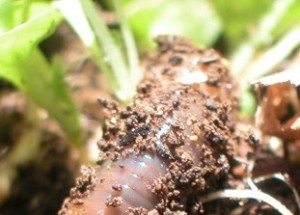
One of our readers reached out to us with this question: Do earthworms have a temperate gland? To answer this question, we will dedicate this article to exploring the ideal environment for an earthworm and discussing how an earthworm regulates its temperature.
First, let’s discuss the basics of how humans regulate their temperature. In humans, the hypothalamus (a region of the brain) works with the skin, sweat glands, and blood vessels to heat and cool the body. The hypothalamus keeps tabs on your body temperature, and sends signals throughout your body when adjustments need to be made. So, when you are cold you start to shiver, and when you are hot you begin to sweat.
Unlike humans (or other mammals), earthworms are cold blooded and cannot maintain their internal body temperatures independently from the outdoor environment. The best temperature range for an earthworm to thrive at is between 60 and 80 degrees Fahrenheit. While this is the ideal range, an earthworm can survive outside this range, but they must change their behavior accordingly. An increase in external temperature is matched by an increase in their metabolism. So, in hot weather, earthworms either have to eat more, or burn their fat stores. Similarly, a decrease in temperature is matched by a decrease in metabolism. Of course, there are limits to the temperatures at which an earthworm can survive. Worms can’t survive temperatures below freezing, or above 95 degrees Fahrenheit.
As with most species, the outdoor environment can also predict the life expectancy of an earthworm. Most earthworms in their natural environments only live for a few months. However, earthworms that live at higher temperatures usually have shorter lives because their bodily functions are working on overdrive. On the other hand, in an environment that is protected and has controlled temperatures, earthworms can live several years!
In addition to temperature, moisture levels can change the lifespan and quality of an earthworm. Earthworms don’t have lungs to breathe, instead they absorb oxygen and carbon dioxide through their skin by a process called diffusion. However, diffusion can only successfully occur if the earthworm’s skin is moist. Earthworms thrive in moist soil, but will struggle and possibly perish in soil that is either too dry or too wet. The best soil for an earthworm is loose and composed of sand, silt, and small amounts of clay.
So, finally we will return to our reader’s original question: Do earthworms have a temperate gland? The answer is technically no, earthworms do not have one specific gland in their body dedicated to regulating and maintaining their body temperature. As we have explored in this article, both temperature and moisture can affect the lifespan and quality of life of an earthworm, but earthworms can’t maintain their body temperature in the same way that a warm-blooded organism can.
All About Worms is always free, always reader-supported. Your tips via CashApp, Venmo, or Paypal are appreciated! Receipts will come from ISIPP Publishing.
You might also find these guys interesting!


















Great article on earthworms!